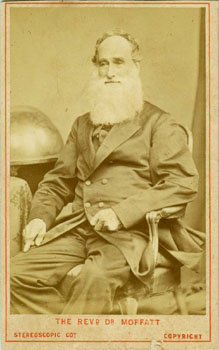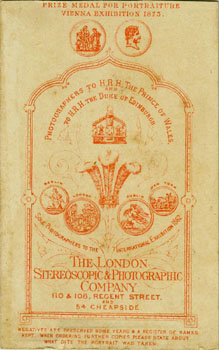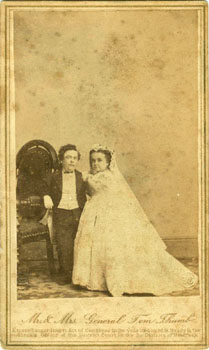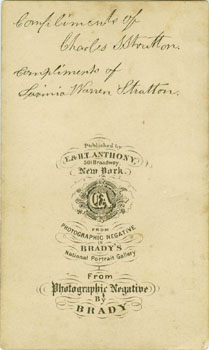

As a young man Robert Moffat (1795-1883) was sent by the London Missionary Society to Africa in 1816. He and his wife Mary settled at Kuruman, where they built a mission and remained there until 1870, when they returned to England. They had ten children, their oldest daughter Mary marrying famous African explorer, David Livingstone (1813-1873). During his time in southern Africa, Moffat made several journeys into neighbouring regions such as Matabeleland (later in Rhodesia, now part of Zimbabwe), and published accounts of the trips both through the Royal Geographic Society and as a book, Missionary Labours and Scenes in South Africa (1842). His grandson Howard Unwin Moffat (1869-1951) subsequently served as prime minister of Southern Rhodesia from 1927 to 1933. According to Wikipedia, "His government passed the 1930 Land Apportionment Act, which defined the pattern of land allocation and ownership and is viewed as being one of the ultimate causes of the land disputes in Zimbabwe from 2000." To explain my interest in this particular cdv, one of Robert's descendants was a friend of mine while I was a school boy growing up in the Eastern Districts of Rhodesia.


The pair in the second example were amongst the most popular non-royal subjects for cartes de visite in the 1860s and 1870s, which was probably the heyday for the Victorian phase of this collecting craze. Mr & Mrs General Tom Thumb were creations of the impresario P.T. Barnum (of Barnum & Bailey fame). The midgets' real names were Charles Sherwood Stratton (1838-1883) and Lavinia Warren Bump (1841-1919). (Of course, he wasn't a general at all, or even a soldier.) They were married on 10 February 1863 at Grace Episcopal Church, New York City, the reception at the Metropolitan Hotel being a huge social occasion with over 2000 guests. This particular portrait appears to be one of a series taken by reknowned American photographer Mathew Brady (1822-1896) on the day of the wedding, and subsequently licensed to E. & H.T. Anthony, publishers of 501 Broadway, New York. An article forming part of a presentation of Brady's portraits by the National Portrait Gallery at the Smithsonian Institution includes the following:
Mr. and Mrs. General Tom ThumbAnother of Brady's portraits, including the bridal couple with the officiating minister and witnesses, "Commodore" G.W.M Nutt (another of Barnum's protegés) and Lavinia's sister Minnie Warren, is shown below.
On February 10, 1863, "The Little Queen of Beauty" married international celebrity "General Tom Thumb" in a lavish ceremony at New York's fashionable Grace Church. The two performers enjoyed a true romance before announcing their engagement, which Tom Thumb's employer, P. T. Barnum , promoted to the hilt. For weeks before the wedding, crowds of 20,000 or more paid $3,000 a day to see the bride-to-be and her engagement ring. Barnum received 15,000 requests for tickets to the reception (which cost $75 each). On the wedding day, crowds blocked Broadway for hours, and newspapers published pages of detailed descriptions of the "Fairy Wedding," the gifts and the guests, who included New York's most fashionable families. Barnum completed the wedding party with best man "Commodore" George Nutt and Minnie Bump, Lavinia's actual sister, and for years the group toured the globe, eventually reaching Japan, China, Australia, and India. Brady made many carte-de-visite photographs in preparation for the wedding, an arrangement that doubtless profited everyone, including the performers, who sold portraits wherever they appeared.

I was intrigued by the "signatures" of Charles and Lavinia Stratton on the reverse of the card mount, imagining the happy couple signing thousands upon thousands of them. However, a close examination and comparison with other examples found on the net show that they are not just similar, but identical, and must be printed facsimiles printed on the card. The carte de visite shown below, currently attracting bids of over £40 on eBay, picturing Minnie Warren and Charles and Lavinia Stratton, may have been taken in London on one of their visits to England, and published by the ubiquitous London Stereoscopic & Photographic Company (who also produced the Robert Moffat cdv above).

Another feature of these portraits of famous people - at least on those from the US - is that they were often blind stamped with marks, symbols or monograms, possibly indicating that the photographs had been copyrighted. Two of these (a flag and the initials CAW, or perhaps GAW/GWA/WAG) can be seen on the reverse of the London Stereoscopic cdv of the Stratton-Warren family above. The cdv of the Strattons published by Anthony shows similar, but not identical, blind stamp marks on the front. If any reader can shed light on these marks, what they mean, and how to interpret them, I would be most grateful (email me).









A very interesting and informative post, Brett. I knew next to nothing about CDVs when I began reading your blog sometime ago, and you have sparked an interest in me in these delightful images and collectibles.
ReplyDeleteI'm very glad to hear that these articles are being read, and that you are finding the information of interest. I, too, knew very little about old photographs and photohistory when I started this blog, but I enjoy so much the process of learning and sharing what I've learnt. If you find any old photos that you think might be of interest in a general sense or that you'd like to learn more about, please consider sharing them. I think the more we write about it, the more interest we will generate.
ReplyDeleteRegards and best wishes, Brett
Love the photo of Robert Moffat being worn by his very impressive beard, but Charles and Lavinia's wedding is my favourite :-) Thanks for this and look forward to your next post. Jo
ReplyDelete